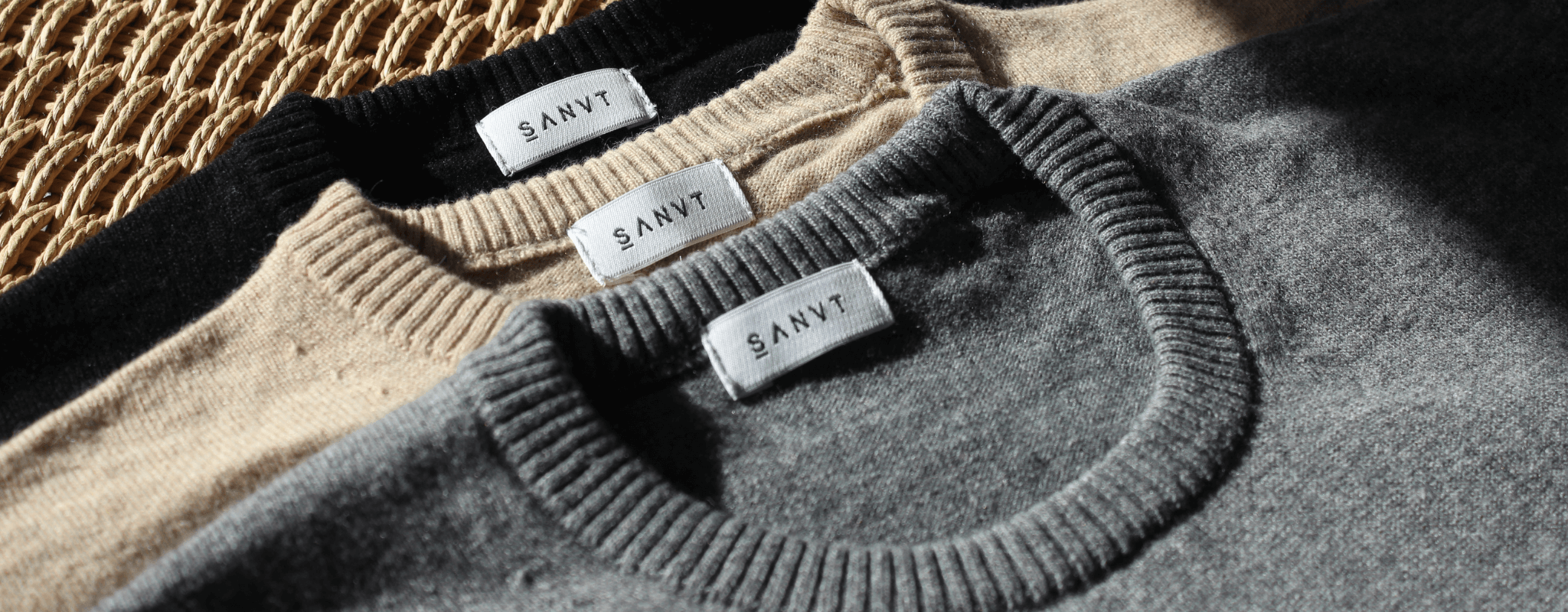Cotton and wool are two of the most popular and common textiles in the fashion industry. Both fabrics are biodegradable natural fibers that have an ambivalent reputation in terms of sustainability, ethics, and environmental friendliness. Therefore, at SANVT, we have listed the pros and cons of both fabrics and will tell you what to look out for when buying cotton vs. wool.
Pros and cons of cotton
Cotton is unquestionably one of the most widely used fibers in the textile industry. The natural fiber is used for a variety of garments, including t-shirts, sweatshirts, jeans, dresses, and underwear. Cotton has many advantages, such as unbeatable softness and breathability. The natural fiber is also very low maintenance and can be washed easily in the washing machine without shrinking or fuzzing.
However, cotton also has its disadvantages, particularly in terms of environmental friendliness and ethics. Although cotton is considered a natural fiber, the Organic Trade Association (OTA) describes it as the "dirtiest crop in the world". This is because the cultivation of cotton requires immense amounts of water, fertilizers, and pesticides, which significantly harm the environment as well as cotton farmers and consumers. It is estimated that between 7,000 and 29,000 liters of water are needed to produce one kilogram of cotton, depending on the growing conditions and the type of cotton. The amount of water is a particular problem in areas with limited water resources, as the intensive cultivation of cotton can lead to the overuse of groundwater. Additionally, various processes such as spinning, weaving, dyeing, and finishing again require between 1,500 and 3,000 liters of water.
It doesn't end there, many cotton farmers in developing countries are often forced to work under poor working conditions and for low wages. Thus, cotton has a very ambivalent reputation when it comes to sustainable and fair conditions in fashion. We recommend buying only fair trade and GOTS-certified organic cotton products that do not use chemicals and pesticides – preferably ELS cotton fibers, which are extra long and thus extra robust and durable in addition to the organic quality.
You can read more about how cotton is becoming more sustainable here.

Pros and cons of wool
Wool is a popular natural fibre derived from sheep and other animals such as goats, camels, and alpacas. As a biodegradable and renewable resource, wool has many advantages, including its quality and warmth. That's why the fabric is especially great for knitted jumpers, cardigans, and scarves. Wool is also very robust and durable, which is why wool jumpers are known to last for many years, if not decades.
However, wool, just like cotton, has some drawbacks – not only for environmental reasons but also for animal welfare. While wool is marketed as one of the most sustainable materials, the production of wool also requires a lot of water and energy. Though it is estimated that only between 100 and 200 litres of water are needed to process one kilogram of wool, it does not include the care of the animals during production! It is also important to be aware that the animals in wool production are often kept under poor conditions, especially in factory farming. Whether it is alpaca, cashmere, angora, or mohair, the production of wool is usually associated with horrendous animal cruelty, mistreatment, bloody cuts and infections.
There are also concerns about the environmental impact of sheep farming. In particular, mass production can lead to overuse of grazing land, which can cause soil degradation and erosion. Furthermore, the use of pesticides and fertilisers in sheep farming can have significant environmental impacts. Another drawback is that some people may be allergic to wool. Skin irritation or itching is also not uncommon, as wool is often treated with chemical processes that irritate our skin.
We therefore recommend buying recycled or second-hand wool products, as animal-friendly certifications are unfortunately not always reliable. For recycled wool products, we advise you to look for the "Global Recycled Standard" seal. This transparent GRS label ensures that all social, ecological, and chemical regulations are adhered to in production and that neither humans nor nature (or animals) are harmed by the manufacturing process.

Cotton vs. wool at SANVT
Both natural fibres are popular materials in the fashion industry and are considered particularly sustainable when social, environmental, and animal-friendly measures are taken into account. Both fabrics are also ideal for knitted jumpers and sweatshirts, which is why we use both of these fibres for our exclusively sustainable products at SANVT.
Our Wool Blend Sweater and Wool Blend Roll Neck by SANVT are made from 100% GRS certified recycled materials. The luxurious material mix of wool (30%), viscose (30%), cashmere (5%), and polyamides (35%) guarantees extra softness and comfort. In addition, we offset the production-related CO2 emissions and donate to the local project Bergwaldprojekt e.V. Oberallgäu, so that the product is also 100% climate neutral.
Our Perfect Sweatshirt, on the other hand, is made of 100% finest, combed, and GOTS-certified organic cotton. During the combing process, fibres are smoothed, and fine impurities are removed by hand. This results in an even finer yarn, which is ultimately the secret to our French Terry's exceptional softness. Our heavy 400 g/m² French Terry with innovative loopback thus guarantees not only sustainability but also premium quality! Handmade in Portugal, fair, and also climate neutral, this timeless jumper is a sustainable basic that no wardrobe should be without!
Cotton vs. wool: conclusion
So, in a nutshell, the sustainability of cotton and wool depends a lot on how and where they are produced. Like pretty much everything these days. However, if cotton is produced under sustainable and fair conditions and wool is recycled, both cotton and wool are sustainable choices for conscious consumers. We recommend supporting sustainable brands and manufacturers that are committed to environmentally friendly practices and animal welfare.
To learn more about our sustainability initiatives, click here.


